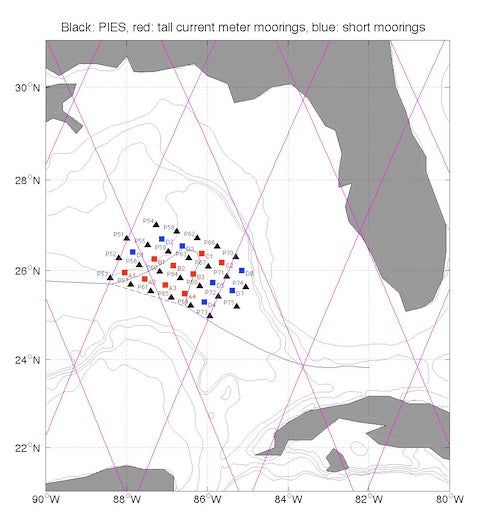
Principal Investigators
- Kathleen Donohue
- D. Randolph Watts
Field Program
2009-2011
Description
An observational and modeling study of the dynamics of the Loop Current (LC) in U.S. Waters, has been undertaken by a team of investigators from the University of Rhode Island (URI), the University of Colorado, Princeton University and Science Applications International Corporation (SAIC) with funding from the Department of Interior, Minerals Management Service (MMS). The overarching goal of this study is to increase knowledge of the dynamics of the LC in the eastern Gulf of Mexico through a combined analysis of observations and numerical modeling. The project site is located in the deepwater area of the Gulf of Mexico Outer Continental Shelf (OCS). The study area consists of the region in the eastern Gulf of Mexico in U.S. Waters north of the Exclusive Economic Zone (EEZ), as far north as 27°N, east of 89°W, and seaward of the 200 m isobath off the west coast of Florida. The project area is centered near 26°N, 86.5°W and includes the internationally disputed area known as the “doughnut hole” which is comprised of the area beyond 200 nautical miles from the coasts of Mexico, Cuba and the U.S.
The main element of the observational program is an array of current meter moorings and pressure senor equipped inverted echo sounders (PIES) that will be used to monitor the spatial and temporal variability of currents, temperture and salinity over a major part of the LC as it passes through U.S. Waters. Field work for this study will occur in three phases: the initial deployment cruise (April-May 2009), a 15-month telemetry/rotation cruise (June 2010) and a recovery cruise (September 2011).
Publications
- Donohue, K. A., D. R. Watts, P. Hamilton, R. Leben, M. Kennelly, and A. Lugo-Fernandez. Gulf of Mexico loop current path variability. Dynamics of Atmospheres and Oceans, 76(2): 174–194, 2016. (doi:10.1016/j.dynatmoce.2015.12.003)
- Donohue, K. A., D. Watts, P. Hamilton, R. Leben, and M. Kennelly. Loop current eddy formation and baroclinic instability. Dynamics of Atmospheres and Oceans, 76(2): 195–216, 2016. (doi:10.1016/j.dynatmoce.2016.01.004)
- Hamilton, P., K. Donohue, C. Hall, R. R. Leben, H. Quian, J. Sheinbaum, and D. R. Watts. Observations and dynamics of the Loop Current. OCS Study BOEM 2015-006, U. S. Dept. of the Interior, Bureau of Ocean Energy Management, Gulf of Mexico OCS Region, New Orleans, LA, 2014. 417pp. (PDF)
- Rosburg, K. Three-Dimensional Model-Observation Intercomparison in the Loop Current Region. M.S. thesis, University of Rhode Island, Graduate School of Oceanography, 2015. (PDF)
- Rosburg, K., K. A. Donohue, and E. P. Chassignet. Three-dimensional model-observation comparison in the Loop Current region. Dynamics of Atmospheres and Oceans, 76(2): 283–305, 2016. (doi:10.1016/j.dynatmoce.2016.05.001)
Presentations
Ocean Sciences Meeting, Honolulu, Hawaii, February 2014
- Donohue K. A., D. R. Watts, P. Hamilton and R. R. Leben. Eddy-mean interaction during Loop Current eddy formation. 14260, 2014. (PDF)
- Hamilton, P., J. Sheinbaum, K. A. Donohue, R. R. Leben, and D. R. Watts. Ekman, Franklin and Hadal: Loop current eddy separation and statistics from observations. 13573, 2014.
- Rosburg, K. C., K. A. Donohue and E. P. Chassigne. Comparison of the 1/25° ssimilated Gulf of Mexico HYCOM with observations in the Loop Current eddy formation region. 14270, 2014. (PDF)
Ocean Sciences Meeting, Salt Lake City, Utah, February 2012
- Donohue K. A., R. Leben, P. Hamilton and D. R. Watts. Upper-lower layer coupling in loop current eddies Ekman and Franklin. 2012. B1331. (PDF)
- Hamilton, P., R. R. Leben, K. A. Donohue, J. Sheinbaum, and J. Candela. Cyclone development during the detachments of Loop Current eddies Ekman and Franklin: a historical perspective. 2012. B1332.
- Rosburg, K., K. A. Donohue, and E. Chassignet. Performance evaluation of HYCOM Gulf of Mexico model. 2012. B1333. (PDF)
This project is funded by the U.S. Department of the Interior, Bureau of Ocean Energy Management.
